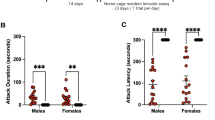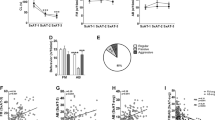Abstract
Treatment with 8.0 mg/kg of fluprazine hydrochloride completely suppressed defensive burying of albino mice directed toward an intruding tiger salamander. This treatment also increased mouse-salamander social distances. The results are consistent with earlier data in suggesting that fluprazine potentiates tearfulness and indicate that this effect extends to nonconspecific intruders as well as novel inanimate stimuli, shock, and conspecifics. This rather generalized drug-induced tearfulness may contribute heavily to fluprazine’s potent inhibition of offense, maternal behavior, play, and predation.
Similar content being viewed by others
References
BLANCHARD, R. J., KLEINSCHMIDT, C. K., FLANNELLY, K. J., & BLANCHARD, D. C. (1984). Fear and aggression in the rat. Aggressive Behavior, 10, 309–315.
BRADFORD, L D., OLIVIER, B., VAN DALEN, D., & SCHIPPER, J. (1984). Serenics: The pharmacology of fluprazine and Du 28412. In K. Miczek, A. Kruk, & B. Olivier (Eds.), Ethnopharmacological aggression research (pp. 191–207). New York: Alan R. Liss.
FLANNELLY, K. J., LIM, H., DIAMOND, M., BLANCHARD, D. C., & BLANCHARD, R. J. (1985). Fluprazine hydrochloride decreases copulation in male rats. Pharmacology Biochemistry and Behavior, 22, 1–4.
FLANNELLY, K. J., MURAOKA, M. Y., BLANCHARD, D. C., & BLANCHARD, R. J. (1985). Specific anti-aggressive effects of fluprazine hydrochloride. Psychopharmacology, 87, 86–89.
KEMBLE, E. D., & SCHULTZ, L. A. (in press). Effects of fluprazine hydrochloride on maternal behavior in mice. Behavioural Processes.
KEMBLE, E. D., SCHULTZ, L. A., & THORNTON, A. E. (1986). Effects of fluprazine hydrochloride on conspecific odor preferences in rats. Physiology and Behavior, 37, 53–56.
KEMBLE, E. D., THORNTON, A. E., & SCHULTZ, L A. (1987). Some fear-potentiating effects of fluprazine hydrochloride in mice. Aggressive Behavior, 13, 269–280.
LATANE, B., CAPPELL, H., & JOY, V. (1970). Social deprivation, housing density, and gregariousness in rats. Journal of Comparative and Physiological Psychology, 70, 221–227.
MEEK, L. R., FREEMAN, L. S., & KEMBLE, E. D. (1988). The defensive burying of garter snakes, tiger salamanders and leopard frogs by albino mice. Unpublished data.
MEEK, L. R., & KEMBLE, E. D. (1988). Effects of dominance status among group-housed male mice on the defensive burying of a non-conspecific intruder. Unpublished data.
OLIVIER, B. (1981). Selective anti-aggressive properties of Du 27725: Ethological analyses of intermale and territorial aggression in the male rat. Pharmacology Biochemistry and Behavior, 14, 61–77.
OWINGS, D. H., & COSS, R. G. (1977). Snake mobbing by California ground squirrels: Adaptive variation and ontogeny. Behaviour, 62, 50–69.
RACINE, M. A., FLANNELLY, K. J., & BLANCHARD, D. C. (1984). Anti-aggressive effects of Du 27716 on attack and defensive behavior in the albino mouse. In K. J. Flannelly, R. J. Blanchard, & D. C. Blanchard, (Eds.), Biological perspectives on aggression (pp. 281–293). New York: Alan R. Liss.
SCHULTZ, L. A., & KEMBLE, E. D. (1986). Prey-dependent effects of fluprazine hydrochloride on predatory aggression in northern grasshopper mice (Onychomys leucogaster) and rats (Rattus norvegicus). Aggressive Behavior, 12, 267–275.
SELSETH, K. J., & KEMBLE, E. D. (1988). Fluprazine hydrochloride decreases play behavior but not social grooming in juvenile rats. Bulletin of the Psychonomic Society, 26, 563–564.
TERLECKI, L. J., PINEL, J. P. J., & TREIT, D. (1979). Conditioned and unconditioned defensive burying in the rat. Learning and Motivation, 19, 337–350.
THORNTON, A. E., & KEMBLE, E. D. (1986). Effects of fluprazine hydrochloride on an olfactory discrimination in rats. Bulletin of the Psychonomic Society, 24, 456–458.
TREIT, D., TERLECKI, L. J., & PINEL, J. P. J. (1980). Conditioned defensive burying in rodents: Organismic variables. Bulletin of the Psychonomic Society 16, 451–454.
TSUDA, A., IDA, Y., & TANAKA, M. (1988). The contrasting effects of diazepam and yohimbine on conditioned defensive burying in rats. Psychobiology, 16, 213–217.
WILLIAMS, J. L. (1987). Influence of conspecific stress odors and shock controllability on conditioned defensive burying. Animal Learning and Behavior, 15, 333–341.
Author information
Authors and Affiliations
Rights and permissions
About this article
Cite this article
Meek, L.R., Gibson, B.M. & Kemble, E.D. Effects of Fluprazine Hydrochloride on Reactivity to a Nonconspecific Intruder. Psychol Rec 39, 203–210 (1989). https://doi.org/10.1007/BF03395063
Published:
Issue Date:
DOI: https://doi.org/10.1007/BF03395063




